See also
- CString, a C string representation in the Microsoft Foundation Class Library (MFC)
C string may refer to:

The cello ( CHEL-oh), or violoncello ( VY-ə-lən-CHEL-oh, Italian pronunciation:[vjolonˈtʃɛllo]), is a bowed (sometimes plucked and occasionally hit) string instrument of the violin family. Its four strings are usually tuned in perfect fifths: from low to high, C2, G2, D3 and A3. The viola's four strings are each an octave higher. Music for the cello is generally written in the bass clef, with tenor clef, and treble clef used for higher-range passages.

Dylan is a multi-paradigm programming language that includes support for functional and object-oriented programming (OOP), and is dynamic and reflective while providing a programming model designed to support generating efficient machine code, including fine-grained control over dynamic and static behaviors. It was created in the early 1990s by a group led by Apple Computer.

The double bass, also known simply as the bass, amongst other names, is the largest and, therefore, lowest-pitched chordophone in the modern symphony orchestra. Similar in structure to the cello, it has four, although occasionally five, strings.

In computer programming, a string is traditionally a sequence of characters, either as a literal constant or as some kind of variable. The latter may allow its elements to be mutated and the length changed, or it may be fixed. A string is generally considered as a data type and is often implemented as an array data structure of bytes that stores a sequence of elements, typically characters, using some character encoding. String may also denote more general arrays or other sequence data types and structures.

The ukulele, also called a uke, is a member of the lute family of instruments of Portuguese origin and popularized in Hawaii. It generally employs four nylon strings.

A string quintet is a musical composition for five string players. As an extension to the string quartet, a string quintet includes a fifth string instrument, usually a second viola or a second cello, or occasionally a double bass.
String or strings may refer to:
A string literal or anonymous string is a literal for a string value in the source code of a computer program. Modern programming languages commonly use a quoted sequence of characters, formally "bracketed delimiters", as in x = "foo", where "foo" is a string literal with value foo. Methods such as escape sequences can be used to avoid the problem of delimiter collision and allow the delimiters to be embedded in a string. There are many alternate notations for specifying string literals especially in complicated cases. The exact notation depends on the programming language in question. Nevertheless, there are general guidelines that most modern programming languages follow.

A twelve-string guitar is a steel-string guitar with 12 strings in six courses, which produces a thicker, more ringing tone than a standard six-string guitar. Typically, the strings of the lower four courses are tuned in octaves, with those of the upper two courses tuned in unison. The gap between the strings within each dual-string course is narrow, and the strings of each course are fretted and plucked as a single unit. The neck is wider, to accommodate the extra strings, and is similar to the width of a classical guitar neck. The sound, particularly on acoustic instruments, is fuller and more harmonically resonant than six-string instruments. The 12-string guitar can be played like a 6-string guitar as players still use the same notes, chords and guitar techniques like a standard 6-string guitar, but advanced techniques might be tough as players need to play or pluck two strings simultaneously.
The C standard library or libc is the standard library for the C programming language, as specified in the ISO C standard. Starting from the original ANSI C standard, it was developed at the same time as the C library POSIX specification, which is a superset of it. Since ANSI C was adopted by the International Organization for Standardization, the C standard library is also called the ISO C library.
%s may refer to:

Guitar tunings are the assignment of pitches to the open strings of guitars, including classical guitars, acoustic guitars, and electric guitars. Tunings are described by the particular pitches that are made by notes in Western music. By convention, the notes are ordered and arranged from the lowest-pitched string to the highest-pitched string, or the thickest string to thinnest, or the lowest frequency to the highest. This sometimes confuses beginner guitarists, since the highest-pitched string is referred to as the 1st string, and the lowest-pitched is the 6th string.
Deletion or delete may refer to:
An extended-range bass is an electric bass guitar with a wider frequency range than a standard-tuned four-string bass guitar.

"Who Do You Love Now?" is a song performed by Australian singer Dannii Minogue and Dutch DJs Zki & Dobre, performing under the group name Riva. The track began originally as an instrumental-only called "Stringer", which soon became a club hit. The record was released on 19 November 2001 through the Double F Double R label. It was later adapted into a vocal version for Dannii Minogue, written by Victoria Horn. For the Canadian market, Minogue recorded a French-language version of the song called "Est-ce que tu m'aimes encore?". The single was cancelled in Canada but was later released in France as the B-side to "I Begin to Wonder". Initially released as a stand-alone single, the song was later included on Minogue's 2003 album Neon Nights.

The thong is a garment generally used as either underwear or in some countries, as a swimsuit. It may also be worn for traditional ceremonies or competitions.
The C programming language has a set of functions implementing operations on strings in its standard library. Various operations, such as copying, concatenation, tokenization and searching are supported. For character strings, the standard library uses the convention that strings are null-terminated: a string of n characters is represented as an array of n + 1 elements, the last of which is a "NUL character" with numeric value 0.
Kotlin is a cross-platform, statically typed, general-purpose high-level programming language with type inference. Kotlin is designed to interoperate fully with Java, and the JVM version of Kotlin's standard library depends on the Java Class Library, but type inference allows its syntax to be more concise. Kotlin mainly targets the JVM, but also compiles to JavaScript or native code via LLVM. Language development costs are borne by JetBrains, while the Kotlin Foundation protects the Kotlin trademark.
Swift is a high-level general-purpose, multi-paradigm, compiled programming language developed by Apple Inc. and the open-source community. Swift compiles to machine code, as it is an LLVM-based compiler. Swift was first released in June 2014, and the Swift toolchain has shipped in Xcode since version 6, released in 2014.